I really prefer having things told to me straight, don't lie to me and then give an excuse as to why you couldn't tell me the truth in the first place. That is why I strongly dislike this common and popular tool of Natural Horsemanship and feel it is of greater detriment to horse and rider than simply putting the facts out there.
First, let's look at what the word desensitize actually means –
de-sen-si-tize
-verb
- to lessen the sensitiveness of.
- to make someone less likely to feel shock or distress at scenes of cruelty, violence or suffering by overexposure to such images.
To me this brings to mind the movie “A Clockwork Orange” in which the guy sits in front of the movie screen being repeatedly exposed to various images. I also imagine preparing someone to go into battle/war or the development of a psychologically impaired individual who no longer recognizes the consequences of their actions.
I've used desensitization before, and I no longer use it in any form and haven't for many years. I have seen it help to wreck fragile minds and be used as a crutch for riders who use desensitization in place of improving their own education and riding skills. It has been marketed coyly by many Natural Horsemanship clinicians which almost leads me off the beaten path into writing about my take on the entire Natural Horsemanship movement and its marketing scheme on a whole. Still, I digress and plan to stay on topic for now… perhaps later.
In desensitizing the horse various objects are used which are strange and potentially frightening to the horse, repeatedly exposing the horse to them in hopes that the horse will no longer react in what is viewed as a negative manner – such as spooking, running away, the famous blow/snort response and so on. Some horses react more violently than others and may even go into fits of bucking, rearing, striking, etc. Just what is used varies from person to person – commonly implemented are umbrellas, tarps, plastic bags of empty soda cans, bags filled with rocks, cans filled with rocks and giant balls.
I'm going to give people the benefit of the doubt and assume that many of you who are reading this have seen at least one horse being ‘desensitized' in some way shape or form. If you haven't I encourage you to simply search for it on youtube and you'll likely find a plethora of videos documenting the process.
Before I go any further, I will say that there is benefit in exposing horses to various strange objects and situations. My opposition to many of the ways in which desensitizing is under taken lies in all of the “other” that is missing in the equation. The lack of trust between horse and rider, the lack of training in general that exists, that desensitization is considered one of the starting processes in the training plan, and its taking the place of the rider's skill development and education.
NH often markets the use of desensitization practices to riders who are in some sort of situation with their horse that is fear-based. Many of them are new to owning the horse they are presenting to desensitization or even to horse ownership altogether. The horse is often a sensitive or high-energy individual and lacking in training to some degree. This kind of mix is the perfect match for disaster. “Naturally” (pun may or may not be intended) you can look at the superficial situation and say that the horse is overreacting to its surroundings and needs desensitization in order to be safely handled by his owner.
I cannot agree with this, and believe it is purely a fear based reaction and puts all of the blame of the situation on the horse.
I also believe that it inappropriately puts blame on the horse's owner/rider/handler as it assumes they ought to know how to train a horse when they may not yet have the education to be a skilled rider let alone trainer.
So, let's look at the situation from another direction. I think anyone who has been around horses long enough can come to the conclusion that most problems work themselves out when the rider sorts their own issues out and it is rarely a true horse problem. There are cases where a horse has been abused or whatnot and genuinely does not respond in the same way other horses do, but these are rare cases and chances are good your horse does not fall into this category.
Now, if most horse problems are really people problems then the whole point of desensitizing the horse is a moot point – if overstimulation of the horse will solve his spooking then overstimulating his rider should make them so brave they no longer fear falling off, being stepped on, getting kicked in the face or rolled on… ahem. It is the same practice that is going on with treating children diagnosed as ADHD with Ritalin and other speed-based drugs – overstimulate the system in order to cause it to shut down and no longer over-react in their environment. But does that actually cure the problem or simply distract us from the real issue?
My thought exactly.
I rarely see Natural Horsemanship clinicians giving riding lessons – the kind in which aged and experienced horses are used for students to practice their communication skills with. To learn how to balance in the saddle, use their aids tactfully and without interfering with the horse. What I do see are beginner riders learning how to train young, spoiled and abused horses. I think of it like sending a person out to fly a commercial plane without ever having sat in the cockpit before or even flown as a passenger. They do not know the first thing and are not only being asked to perform but to also teach their horse.
Does this look like an educated rider? No helmet, no way to communicate with the horse.
Of course we then see certain actions crop up to deal with the backlash that will happen – namely the horses acting out and their riders not having an education or the practiced skills on how to overcome them without resorting to habits like desensitizing. Shaking plastic tarps at their horse in an effort to “train” them to be a quiet, reliable and trusting mount.
It is a tool that has been successfully sold to thousands (maybe millions?) around the country but it never addresses the root cause of the problem and cannot replace hard-earned trust that develops over time and experiences between horse and rider. Desensitizing is only a drug to overstimulate the horse into ignoring his surroundings. It dulls his mind and actions and can actually interfere with your ability to communicate and build a relationship.
I have owned one gelding who was ruined through desensitizing. At the time I had no education to base my understanding from and so depended upon the ‘teachers' around me to help guide our learning. Unfortunately he had to pay the price and it ruined him emotionally. His responses following I can only compare to someone suffering from post traumatic stress disorder (PTSD). Everything was there to hurt him, nothing could be trusted including people. For the last few years that I worked with him I had finally gained enough education and those were special years in which he settled into a sort of semi-calm but the damage that had been done with overstimulation could never be totally erased.
Take a look at the eyes of horses in Natural Horsemanship programs that employ desensitization, though they lack hard eyes there is instead a sense of empty sadness, almost as if they are not really involved in what is going on. They are reacting but not interacting and that is a huge difference.
Lastly, I will point out that desensitizing or “sacking out” as it is often referred to, does work. It does desensitize the animal in many cases and also changes the dynamic of the relationship that we can subsequently build with that horse. What is also does is help distract from the real underlying problem and is a tactic that is wholly unnecessary if training is approached correctly following the education of the rider himself (or herself..).
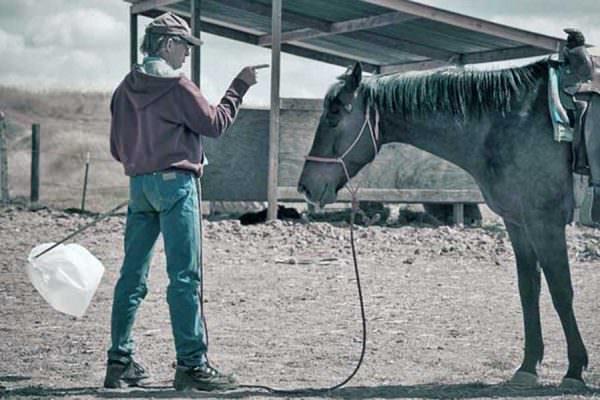
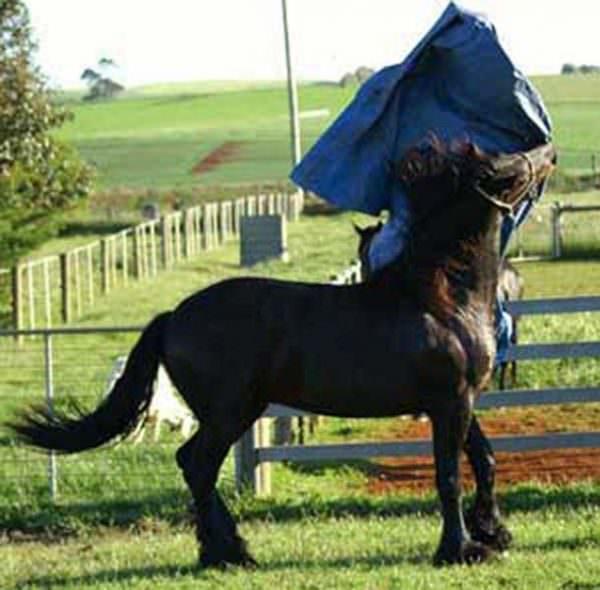
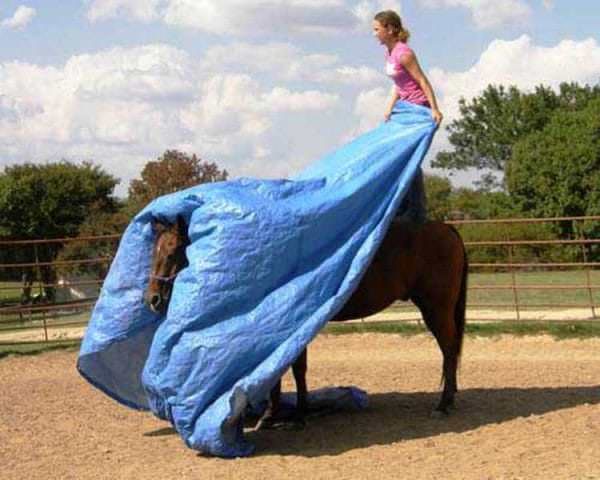

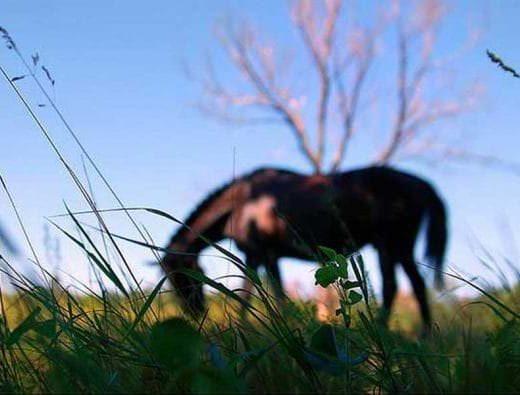
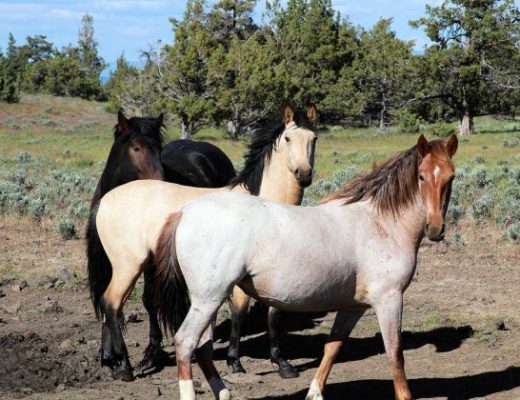
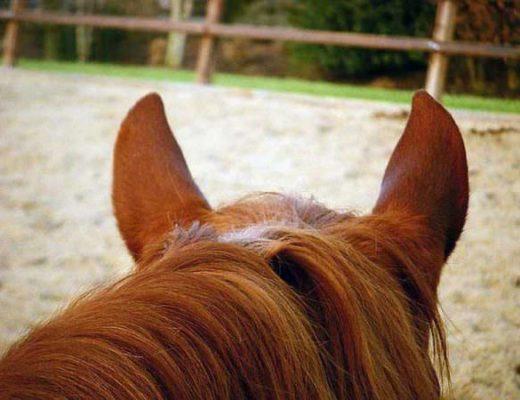
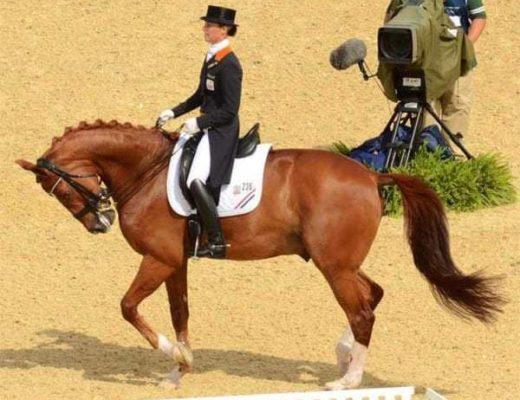
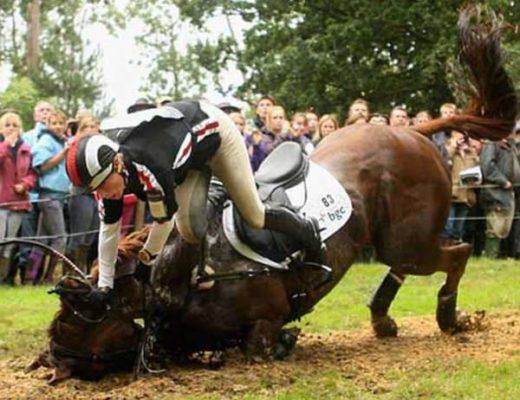
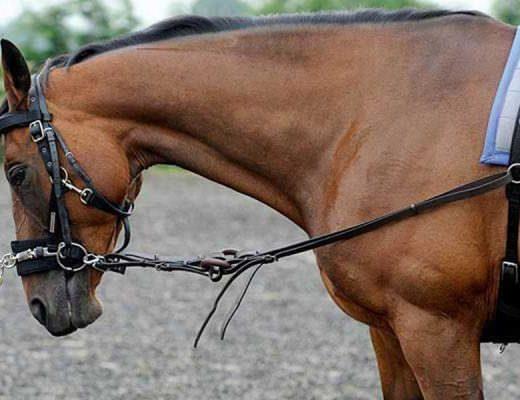
Facebook Comment
Here I disagree with you. I have been using a form of NatHorse that is not Parelli, but stems from old Californian Vaqueros that was brought to Austria by a man named Dysli, and then taught to our trainer, Walter Lukas and then taught to me. It works. When done right and with “feel” you can do wonders with horses. When sold as a “cure all” for beginners that have not invested the time and effort into understanding what is going on, not a fault of their own, then it is a detriment. However, broadly accusing NatHorse, when many horsemen have participated in its development and it has many facets, is in my opionion only “poplulistic”. I beg to disagree here, if you want to attack the Parelli or some other system, its ok, but do not attack NatHorse in its entirety. Or else, come here and see the results first hand.
Facebook Comment
Respectfully Karen, I believe you misread the message of this blog post in particular. One of the greatest selling points of Natural Horsemanship has been to beginning equestrians who prematurely own and train their own horses. In no way did I say the methods do not work, in that case the movement would have fizzled out on its own like so many other fads that come and go.
Natural Horsemanship however does market many tactics to these beginning equestrians – who are the vast majority of their revenue – but do not include instilling the basic skills of being a rider first. As a result things such as desensitizing horses becomes a standard practice in the horse’s training no matter if the ‘problem’ was due to rider/trainer error or not.
Was looking at Youtube videos about lunging and really enjoying watching your examples, then found your blog.
Am surprised about the attitude expressed towards de-spooking, which I have used with my horses as a way to help us build up trust together. I feel that working with them on de-spooking is one of the best things we have done together. We try to expose them to various scenarios they may experience in real life. I don’t use the chase them backwards till they stop NH method, but use a positive reinforcement (clicker methodology) with some approach /retreat of small steps vs any flooding.
We’ve taken them to watch parades pass by, gone to a multi-horse trail practice, walked trails and through neighborhood to help expose them to new sights and sounds. These all are de-spooking experiences, as much as working in the yard with them. I have tried to teach my horses to stop and think before spooking, plus to trust my guidance. They are much better at trusting us than when they arrived, as we have bonded over time.
You are probably right that if I was a good rider that some of the de-spooking on the ground would not be necessary. I do have more confidence that my horse won’t flip out from a blowing plastic bag or a Boy Scout with a backpack or a bicycle, etc. It seems a good thing to have done on the ground first and then in a controlled area under saddle.
One can never de-spook to everything, so it is the trust that is the point of such sessions. The horse also learns to be braver and more curious and to learn to think and not just react. When we see our first llama, then hopefully we will have built up a communication and trust to not overreact and be safer together.
Meg
Hi Meg,
I am glad you voiced your thoughts on my post. I am thinking about reworking it as my intentions in it have not come across the way they were intended. If only training horses worked the same way – simply edit out the miscommunication. 🙂
Helping our horses become accustomed to things which they are going to be exposed to either regularly or by chance is part of the process of building trust, I absolutely agree with you 100%. My objection is not to that method of working with our horses, but rather the way in which many clinicians go about promoting desensitization in a way that is neither conducive to building trust nor safe for the amateur audience they are pitching it towards. Part of the issue there is their audience needs a certain amount of education to even know they are being put in danger – which the clinician is not providing.
Many of the stunts I am referring to are those in which the horse is pushed too far and too fast, but it is by the amount of skill and timing that these clinicians have in avoiding being hurt that another equestrian without the same amount of experience or ability to read the horse is going to get put in a bad position. This doesn’t build trust with the horse nor accomplish safety between the two.
On the other side of the spectrum as well are those equestrians who have a measure of tact and speed and are less skittish about bringing out explosive reactions from their horse, and in those cases you can often see horses who have been overly-desensitized. They are dulled down and near lifeless when it comes to interacting.
It sounds like the time you are taking with your horses is beyond the measure of value. 🙂 It is like building a friendship/relationship with any other person and the time spent is one of the most important aspects. I’ve found there are great qualities as well in the clicker style approach.
Erica K.
I believe desensitization to be a potentially misleading and dangerous method of training. Horses that come to me with spooking, rearing, bucking problems generally stem from a trainer (rider) that has made it feel like it has no option. It must submit. I use guided, purposeful movement to make a horse realize entrapment or lack of choice is not my goal. I had a horse that was forced to stand still for things and if you were not strong he would be dancing all over the place. I made him move more when he wanted to jig and he soon learned that he had the freedom to move and then chose to stand still. When a horse spooks or bucks or rears, a rider generally punishes or inadvertently rewards (falling off soon releases pressure on the horse) and the horse learns to associate certain places and things with fear.
I had a horse that would buck with the saddle on but only when the girth was not elasticized on at least one side. He did not enjoy the lesser ability to breathe deeply without the elastic. Should I desensitize him to stiff girths? Should I make him feel like he can’t breathe and make him eventually get over it? I sure would hate to wear a bra that was ungiving and made me feel incapable of breathing. I have thoroughbreds who can’t stand flies – should they too learn to get over it?
We tend to take methods that work and think they are fine because they work. I would rather listen to what the horse is telling me and adjust myself to his comfort. That does not mean he stands in the pasture all day stuffing his face. There are very practical, safe ways to get the horse to perform contentedly without reducing the thickness of its skin.
Bravo, thanks for this article. I was someone who believed the majority must be right so therefore sacking out must work. I wasted so many hours exposing my horse to everything I could think of. What I discovered is that I will never understand how a horse’s eye and brain work together. I have two energetic, reactive Arabs. Either of them can see the same object on one day and find nothing unusual about it and see the very same object in a different light or under different circumstances and find it extremely alarming or life-threatening. I learned that I had to train myself. If I wanted to ride reactive (and to me, fun) horses, I needed to learn how to ride spooks and to calm myself down quickly after the initial reaction. Just being confident in myself has reduced the number of reactions my horses have. 90% of the spooks were caused by my horses reacting to my tenseness and to me looking around for whatever might spook them. Farriers have told me that if my horse doesn’t stand still for an hour while they are doing a trim that my horse needs to be sacked out. I tell them that my horse is not fearful but my horse is fit and can’t stand still for an hour in the pasture or stall either. Sacking out seems to be a popular cure all for many unrelated problems.
Dear Erica,
I have been pondering this same issue with horses and in fact recently wrote a blog about it; Learned Helplessness in Horses. Untill I could put a name on my feeling around this type of training, I couln’t get a handle on it. I would say I do use some ways of de-spooking, like getting the horse ok with blowing tarps and strange things, but very, very, very gradually. I was delighted to find your blog and to know you are nearby – I live on Orcas Isand. Nice not to be alone in one’s thoughts about horse training!
Kate Wood
LifeOnOrcas.Blogspot.com
Kate – I too was glad to find this article. People tend to forget that horses are animals of prey and learned helplessness can be a method of defense.
I do use a lot of Natural Horsemanship methods but as you pointed out that is with an already fundamental understanding of the horse and years of riding lessons and experience under my belt. I do come across a lot of people that become romanticized by the idea that they can just buy this video some equipment and presto. Knowledge and understanding , the hows and whys have got to be known. As with any individual pursuit it needs to be approached with education and understanding.
Yes, they sell a lot of stuff to newbies and I’ve heard in lots of Dressage forums about stick whacking. But then in their world there are a lot of problems as well like Rokur. I appreciate those in both worlds that look for the proper education for the person and the horse. Interesting and challenging writings. Thanks.
Amber,
You are absolutely right – there is no discipline that is perfect. It is simply a style of riding. Rollkur actually exists in all of the disciplines – just called different things and used in varying extremes. There are gadgets in every discipline promising results and so forth.
Education is what simplifies everything. It minimizes your need for ‘things’ and ‘tricks’. Isn’t that the goal with our horses anyways – to just be the two of us able to communicate simply and freely? 🙂
Cheers
Communicate simply – thank you.
Erika,
I think people are having problems with a couple of things here, especially the semantics…for most people, desensitizing has become synonymous with de-spooking. It can be done correctly, to introduce a green horse to a variety of objects and situations, and to raise the level of horse-human trust. Or it can be done very badly, in which the horse “shuts down” or explodes in the interest of self-preservation.
So I would suggest a new term to recognize the positive aspects of de-spooking: let’s call it “acceptance training” or “tolerance training” or — my favorite — “trust-building.” I always seek out trust-building training opportunities, chances to introduce my horses to objects and experiences that will build their knowledge, understanding, trust in humans, and create an ever-more extensive repertoire of situations that they are confident in knowing how to handle.
I do use all the standard stuff — tarps, umbrellas, pool noodles, garden hoses, plastic bags, traffic, bicyles, motorcycles, noises, whatever I can think of that can also be introduced safely. (See The Power of Positive Horse Training, published by Howell Equestrian Library). But instead of shoving these things at the horse until he gives in and becomes cowed, I use his natural curiosity and a rewards toolbox to build a trust relationship and a history of acceptance. When confronted by something entirely new and maybe scary, my horse’s first response is “hey, what’s that? Does it relate to anything else I know?” and their second response is, “ok, mom, how do we handle that?”
I want my horses to be sensitive to their surroundings, but sensitive doesn’t mean overly reactive. All of training consists of a dialogue that asks the horse to “pay attention to this particular stimulus, and give this particular response,” after which the trainer says, “yes, thank you;” or “not quite, let’s try again.” The correct response to blowing tarp may be to continue standing quietly, or to walk straight on by, but at no point do I say, “ignore this, it doesn’t really exist, you must be dead to your environment!” That would be denying the horse’s perception of reality. OF COURSE he sees the tarp, and so do I. So I will go out of my way to give him the tools to deal with it safely.
Sarah
Sarah,
I think your explanation of the differences between de-spooking and desensitizing is very well put, but still disagree with the reasoning behind it. To me, the reason is because the focus is on the object that the horse is afraid of rather than focusing on why the horse is afraid to begin with. The fear is from a lack of confidence – whether in himself (the horse) or in you (the equestrian) which also equates to his trust in you… and in turn comes back to the relationship with the horse. What is the difference between a giant water noodle and a curry comb? Why is it understandable that the horse would be afraid of blue tarp but not the railing in an arena? Is a blue tarp something that scares us?
I’ve approached horses in both ways just because of the way that I was taught coming into horses. I’ve taken them through the obstacle courses and exposed them to a plethora of strange encounters. Does it work? Yes, it can work – but it does not work 100% of the time for 100% of horse/rider teams. I’ve also taken horses through and dealt with their fear of objects without even dealing with the objects. Why? Because there will always be SOMETHING that the horse can find a reason to be frightened of if the underlying cause is not dealt with. The reason I see working with objects working for some teams is because the rider approaches it in a manner that builds trust, not because it has anything to do with the objects. The horse/rider teams that do not find success are those that are focused on the aim being acceptance of the object, not the manner in which the horse accepts the object.
The same can be done without any of those items in the barn – by doing what ought to be happening in the first place, building a relationship with your horse that is based on simplicity, patience, communication and positive reward. Just like going on an adventure with someone you do not trust vs one you do trust – which one will you be constantly doubting and questioning?
I like that you also mention not wanting your horse to be dead to your surroundings – to be interactive. That is vital! 🙂 I too strive constantly to see my horses communicating without hesitation because they are a part of the conversation rather than making them feel like they are butting in on a monologue.
Cheers,
Erica K.
You make a good point. For the longest time, I referred to my horse as being “desensitized” to most of the scary things such as tarps, umbrellas, flapping laundry, gunshot, water etc…
I was responsible for his training since he was a foal & exposed him to as many “scary” objects as possible as often as possible. He was never forced into any of it. It was a game between him and I, to have strange objects in odd places for him to investigate, sniff and mouth. Rewards were used very often to get him to walk up to the object and look for his favourite treats. To this day, 17 years later, he still walks up to new things and sniffs them. His confidence makes him a very fun horse to be around, even though he can be rather pushy (bad me, I let him.) He’s nearly fearless and very trusting of me. We rode through an obstacle course a year ago and he did everything, at his own pace, sniffing and looking the whole time on a light rein.
You have me realizing my buddy is not “desensitized.” He’s a pushy, nosy, curious and confident pony. He’s happy, too. He whinnies & nickers when he sees me and gallops to the gate when the bridle comes out. We have great relationship, even with the mistakes, founded on trust and, I suppose, “exposure and bonding” rather than desensitizing. Thanks for the article.
Love this, and that you’ve worked with your horse in a way to preserve that curiosity, intelligent interest in his surroundings and new objects, and while he is “accustomed” to much he is not dead to the world.
My horse Jobi is very similar. There are things that he’ll look at a bit longer than others, but letting him check things out at his own pace means he does it once and then knows it’s okay and moves along with confidence.
Cheers,
Erica
I agree with Miss Moo, we need curious and brave horses not desensitized ones. I have been training using natural methods – as opposed to the traditional BHS (Uk based) ones. Yes it is a Parelli program but I do enough to have a safe and fun horse. With my new horses I am just starting liberty work following Leslie Nichols ideas, http://www.equinelibertysports.com and use positive reinforcement to teach new concepts. Parelli is a tool like anything else and not to be followed blindly, if you don’t know why you are doing something then you should not be doing it, (this from a Parelli professional). Even before I heard of Parelli I played with my horses at liberty and online, Parelli just gave me some more ideas. That said I don’t like the hype and showmanship and so many members are like cult followers.
Erica, first I just want to say thank you for this website! I’m loving all of your articles!
Now to the topic. I have had my horses for about 7 years now and have spent most of that time using natural horsemanship (NH) methods. I have always been curious about how those in other disciplines such as dressage or jumpers start their horses. I have since learned a little about that through reading books and the Internet. However, I did not see anything about sacking out. My conclusion was that these horses must be a bit scary to ride and that their riders must have to be very careful to avoid anything scary with them. My search for a better way and a better relationship with my horse is what brought me to look into classical dressage. I have always wondered whether sacking out was a good thing. My horse is particularly scared of new things and I often wonder if I am helping him or further damaging any trust he has in me when I subject him to new things. Now, I don’t just strickly flood him with things and wait for him to accept it. I allow him to see an object and follow it to build confidence, but I also have things come at him and expect him to deal with it. After all that, he is still spooky which has lead me to reevaluate how I do this. I had come to the conclusion that I need to be much more casual and matter-of-fact about exposing my horse to new things. I have been told that if I don’t treat it as a big deal, it won’t be a big deal to my horse either (or at least not as big a deal as it could be). So it does seem to boil down to rider confidence (and skill as you put it). A really confident and skilled rider can do wonders for a horse! So, thanks so much for addressing this topic!
On the topic of NH, I am beginning to realize that yes, it is aimed at beginners like me who don’t have the tools or riding skills to train their horses. With that said, it has helped me a lot and I have always adjusted as necessary as I found out quickly that every scenario or reaction of my horse is not going to be covered on the DVDs! It has not helped my riding much, but my ground skills are pretty good. Now onto a higher level of horsemanship with classical dressage! 🙂
Thank you again for all your great articles!
Hi Stacy,
Thank you for such a thoughtful comment. 🙂
I really think there’s a fine balance between all the tools in every discipline, though most die-hards want to keep them very polarized and separated. There are many great things, and then like anything else in life there are not-so-useful tools as well.
What I’d like to see more of in NH is an emphasis on “these are the tools that work really well as a complete beginner” and then encouragement to keep learning and growing outside of the NH bubble. On the other end of that spectrum I think that other disciplines like Dressage/Jumpers/etc could really benefit by making their riders learn a lot of the basics that NH teaches for a more rounded education.
Certainly Classical Dressage is not without it’s own downfalls, limitations and also false advertising (people using it as a title just to pull in more business), but the tenet I like about it is the idea that you’re combining the teachings of many masters instead of just one person or idea. Many are in conflict with one another even, but it’s about learning all the ideas, applying them and sorting through which work best for you as an individual and also the horses you ride. 🙂
Keep learning, we all are (me included!) and that’s half the fun!
Cheers,
Erica
I concur! I think it’s a good idea to be familiar with many training methods and take what works and is best for the horse from each.
Regarding classical dressage, yes I’m already learning that trainers use the term to describe themselves, but then don’t stick to the principals. I have seen horses with their mouths tightly clamped shut, draw reins being used, girthing up in one shot while horse is visibly pissed off by it, see-sawing, albeit gently, the reins to get the horse’s head down. I observe this and just take the good things these people have to teach. However, why are there so few real classical trainers and why do they have to be so far from me? 🙁
Since I mentioned it, can you explain why ‘see-sawing’ the reins is bad for the horse? (I’m talking about alternately squeezing the reins, which I have read is a form of see-sawing.) I read that it can develop a habit in the horse of bobbing his head from side to side. But, is it actually physically bad for the horse? I have read that a horse will relax his head and neck when you ride him properly from back to front, so I realize the see-sawing is a short-cut and working from the wrong end of the horse. But I’m still curious what else is wrong with it. This trainer I saw used this to lower the horse’s head (not hyperflex; just to get long and low). The horse was in a hackamore. Is this wrong?
Thanks for sharing your wisdome!
ha, I think it goes when great things occur it is in scarce amounts. When scarce things occur it is in great amounts, and of course you can fill in the middle ground following that. 🙂
The same is really seen in creative arts as well – the greatest master artists are rarely valued in their lifetime. Those celebrated the most while alive are quickly forgotten and we lament missing the geniuses.
From my own experiences, I see most actions used on the reins as being overdone. They’re strong, harsh, rough, inconsistent.. violent. I imagine the horse’s mouth as being infinitely more sensitive than the barest bony part of our body, then imagine that bony surface being ground against a hard surface. But even that idea is insufficient – the amount of soft tissue covering the horse’s jaw where it makes contact with the bit is minuscule compared to the thickness of our skin.
Think about it like this – it takes approximately 5 grams of weight/pressure to make permanent changes to the physical tissues of the body. That’s the weight of a nickel. Last I recall the USDA cites 2lbs of pressure on each rein as a standard amount for ‘light’ contact with the horse’s mouth. 5grams vs (2x2lbs)… and I would say that 2lbs is light compared to a a large majority of riding I see across disciplines. That’s just in a snaffle, then if you’re adding any type of leverage/curb bit you have to multiply and you can see 1lb of rein pressure amount to over 100lbs in the horse’s mouth depending on the bit style.
See-sawing is no more evil than any other overuse of the reins, imo. But it is an overuse of the reins. It is the rider giving up on communicating with the horse and simply resorting to physical bullying. Imagine someone asking you to please walk in front of them vs someone twisting your arm behind your back and forcing you to walk ahead of them. Same result but very different means of achieving it – and it also impacts the relationship you’ll have with that person in a significant way.
My own ideal practice is that any backward action on the reins is to be avoided at all costs. Any other direction is fine; up, down, left, right, forward, any combination of those. But backwards is always a pull against the horse, and when you pull against the horse he will push against the reins and it becomes a contest of strength – the horse will always win while also being on the losing (painful) end. Very hard to master, you’d be surprised how mindlessly our instincts are to pull back on the reins, but the change you see in the horse is remarkable.
And how that relates to see-sawing is that by it’s very nature see-sawing is pulling back on the horse’s mouth. It is with a single rein at a time, but pulling back none-the-less. It’s aim is to create discomfort on the horse’s mouth, to cause him to give while the rider is pulling on him. Pulling on both reins makes it easier for the horse to push against the reins.
To address head position – yes riding the horse from back to front is the correct method, but I find this description very vague for most to wrap their heads around and really utilize it in practice. Think of it like this – ride the horse with your reins always moving from back to front if possible. Back to front is also in contrast to pulling back on the reins. Every horse I’ve ridden in a real frame, connected through their whole body, had one thing in common and that was me riding with zero backwards action on the rein.
The horse doesn’t become afraid of the reins. When there is no fear of the reins he stops resisting your hands and only then can you have a dance partner.
Food for thought. Thanks!
My sentiments exactly – great articles, great points. Thank you.
I’m pretty sure your blog is geared towards hating on anything and everything NH has to offer and showing people that when NH methods are applied incorrectly, they don’t work. I rarely read anything from you that is positive or informative. Its just a bunch of hot air blowing around on the internet. Don’t you feel your time would be better served truly educating people about how to do things properly with their horse instead of attacking clinicians that are trying to make a living helping people with their horses? Why don’t you post a video of you riding and handling your horse so we can see how much of an expert you are? If every one else is doing it wrong, then show us how its done.
you have clearly never looked more closely at people who practice natural horsemanship. It is clear to me, you have scratched the surface and someone somewhere has pissed you off in some way. Dig deeper, this isn’t an article it is a pointless rant. To fully understand what you are trying to talk about, go beneath what you see on the surface. Go beyond those marketing gimmicks and take a look. You’ll be surprised to know just how educated natural horsemanship is.
Bravo! Very well said!
In today’s world of “training” a horse in 30 to 90 days, we are developing horses that are submitting to our will, but are lacking a very necessary foundation of understanding as well as the physical and mental ability to respond properly to the rider. These methods of working horses until they submit, are actually developing horses that are in the “freeze mode” of the “flight” “fight” or “freeze” response to a perceived threat.
When a horse feels threatened – such as being made to run around a round pen or back and forth at the end of a long rope – the horse responds to what he perceives as a threat by running or going into “flight mode.”
When the horse reaches a point where he can no longer run, he turns to face the person making him “work.” This is “fight mode.” (In the old days this was called “turning at bay.”) When the person making the horse work does not engage in a fight, the only place the horse can go is into “freeze mode.”
In today’s world of hurry up training, this freeze mode creates a horse that is numb and will allow the rider to do most anything to him. We see this demonstrated when the horse is immediately saddled, bridled and ridden, all within a 30-minutes or so, from beginning of the session to the time the rider mounts.
Though the horse has no real training in the finer points of balance, movement and communication, much can be mimicked through the use of shank bits, tie downs and weighted reins. The results are a horse that is quiet through numbness and submission, and is performing through force –however subtle the force may appear to be.
In a rush to get horses on the trail or in the show ring, trainers face them with all types of scary things, such as flapping tarps, umbrellas or balloons, etc. This all happens before the horse is allowed to develop confidence in his own abilities or come to trust that the trainer will not hurt, scare or confuse him. Rather than creating a foundation of confidence and trust the horse is being desensitized to these strange objects, which is another way of saying the horse is being kept in “freeze mode.”
Placing a horse in freeze mode creates a quiet horse – as long as he stays in freeze mode. This allows a rider with less skill to ride on simple trails or in amateur shows with some measure of success.
However the question arises: Do we really want to ride a horse that is not sensitive to the world around him or the rider attempting to communicate with him? Would it not be better to have a horse that is fully engaged, aware and responsive to us? Would a better goal be to increase the quality of riding and training?
If today’s riders will begin with a strong foundation that builds a confident, trusting horse, there is no need for submission and desensitizing. Remember, if you start by forcing your horse into freeze mode, eventually he is going to become unstuck and the only other place for him to go is flight or fight. Neither is very fun or very pretty.
I had to read the article and all the comments to make sure you weren’t referring to the process of which every horse has to go through. Like it or not there are things that a horse will be afraid of simply because they haven’t seen it and don’t u understand. For example, exposing a yearling to things such as balls and tarps and walking through the steps with them so they understand it won’t hurt them. It takes time and can’t be done in just one short session. I feel that’s where the Parellis have problems, they take short cuts to get their results, which ends up being not only dangerous but ineffective as well. Also, ADHD, TRUE ADHD, is not treated the way you are describing. Please read up before you use this analogy again. There is a LOT of research that has been done. ADD or ADHD can actually be seen on a PET scan. This is because their neuro synapses have slowed to the point there are areas of inactivity in the brain where it should be. The stimulant actually increases their brain activity, bringing it up to a more normal range. I’m not talking about the over diagnosed “your kid is a brat because his parents ignore him” thing that they “outgrow”. True ADHD Cannot be outgrown, it doesn’t go away, and it tends to be genetic. Adults simply learn to cope. Most have heavy coffee or caffeinated soda habits, and some, like my father, have learned to adapt and can never work for themselves. I realize this is an older post, but requires some education (as we all do) nonetheless.
I think Erica Franz it totally missing the point of “desensitizing”. The real purpose are to instill the habit of relaxing when confronted wtih a “spooky” object or circumstance and for the new people to learn to “read” a horse. The results give safer and more enjoyable horses. From the article it appears he is simply trying to make a name for himself by opposing a fundamental and necessary piece of a training program, and shows a lot of ignorance, on his part, on how to use good methods to train horses and people. A good training program is one that is composed of elements that are safe, humane and effective for the widest range of horses. When a horse is calm and relaxed, it responds to the given commands and ques much more softly and safely.
Hey Phil,
I actually have a very complete and thorough understanding of what use ‘desensitizing’ is for, why people use it, and still believe that it holds very little real value except for clinicians who are trying to make a buck and sell an idea to riders who don’t know better.
Cheers!
I am 100% in agreement with the author. I learned to ride at age 3 on a spoiled mare the previous owners allowed to get away with her antics. She had many issues, however I was more determined than she was & after a few months had her doing & going wherever I asked. My dad had an OTTB gelding with a nervous disposition. If the person on his back was not totally confidant and secure he could sense it & would panic, he ran off with 2 grown men because they got scared which made him totally lose it. I will never forget the day I asked my dad if I could ride him, my mother said, ‘don’t put her on that horse’, but my dad said, she will be fine. I was 5 and traveled many miles on that big horse with never a mishap or spook. I had never heard of NH, my dad was a horseman and my brother and I learned from our horses, neither of us have ever had a ‘bad’ horse. It may sound silly but I believe that leadership & confidence allowed each horse or mule I trained or rode to feel safe in my hands. In 50+ years being with these magnificent creatures, I’ve never been thrown, kicked, pawed or bitten and never used a round pen or lunging in my life.